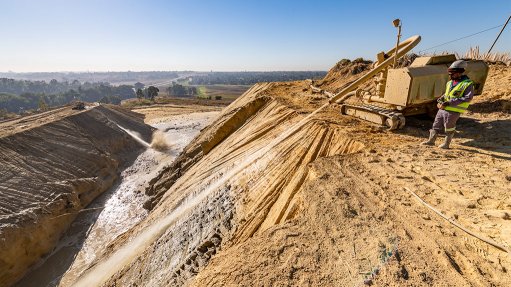
HARD AT WORK DRDGOLD reclaims and retreats gold mining waste – mine dumps – of previous miners
South African gold producer DRDGold is continuing its progress on environmental initiatives having increased its environmental spend by 23% to R51.6-million for the 2018 financial year.
Total spending of R24.9-million in the first six months of the 2019 financial year was 28% higher than the comparable period for the 2018 financial year.
During the 2018 financial year, the company vegetated 35 ha of its tailings deposition facilities, keeping to just seven out of a total of 12 000 dust measurements, the number of measurements exceeding regulated limits which is 0.58%.
Meanwhile, consumption of externally sourced potable water decreased by 38%, to 3.337-million litres, reflecting DRDGold’s investment in its water distribution system. This system allows for more efficient water storage and distribution throughout DRDGold’s operations from three primary sources: its Rondebult sewage water treatment works, its Brakpan/Withok tailings deposition facility and the acid mine drainage treatment facilities of State-owned entity Trans-Caledon Tunnel Authority.
Total potable water consumption was 31% lower at 1.187-million litres for the first six months of the 2018 financial year.
At year-end, an application in respect of 191 ha of land in Gauteng – liberated of slimes and sand dumps rehabilitated by the company – had been lodged with the National Nuclear Regulator for clearance for redevelopment.
DRDGold CEO Niël Pretorius tells Mining Weekly that the company believes that it “has shown considerable capacity to be self-starting, innovative and accountable in terms of environmental impact”.
Core Business
Pretorius believes that DRDGold’s position on mine waste is “quite unique”, as it reclaims and re-treats gold mining waste – mine dumps – of previous miners. The company extracts gold thrown away because of less efficient metallurgical technology available in earlier years.
By pursuing its core business, the company clears old mine dumps that have become problematic over time because they were not designed to meet today’s standards, they are not located optimally in the first place, or they have been encroached upon by human habitation.
Land liberated by DRDGold is rehabilitated and becomes available for redevelopment, while the tailings which remain after the company’s re-treatment process are deposited on modern tailings storage facilities and maintained to modern standards to minimise their environmental impact.
DRDGold’s business strategy is based on the five capitals model – financial, manufactured, human, social and relationship, as well as natural – for sustainable development. In running the business, the company looks for optimal “overlaps and trade-offs” between the capitals, Pretorius states.
“With the funds at our disposal, we work to transform the other capitals in an integrated manner to make our business sustainable and fulfil our mandate for all our stakeholders,” he says.
Environment Priority
Pretorius reiterates that, “mining, like many other economic activities, has the potential to impact negatively on the environment and, if not recognised, can lead to continued environmental degradation”.
He concludes that, in the twenty-first century, there is enough history to reflect upon to understand clearly that the only socially defensible way to mine now and into the future is by planning, implementing and managing mining with the environment receiving as much priority from start to finish as production and profits – and, most of all, doing likewise for when mining activities cease.